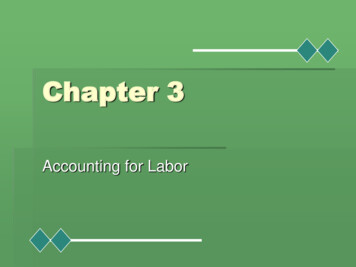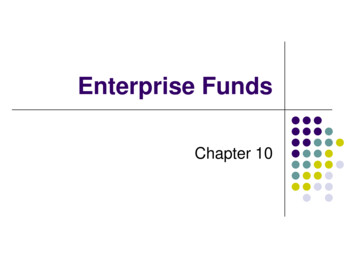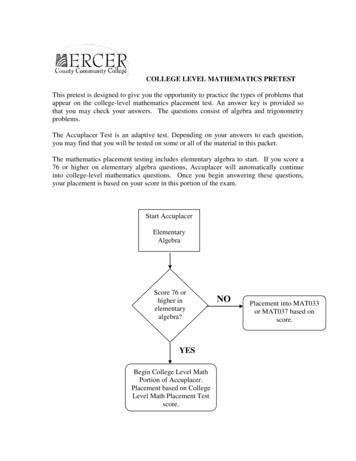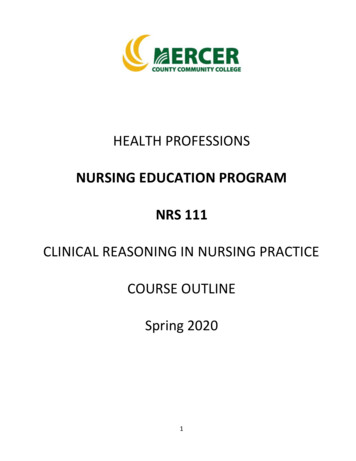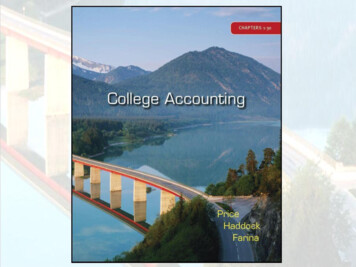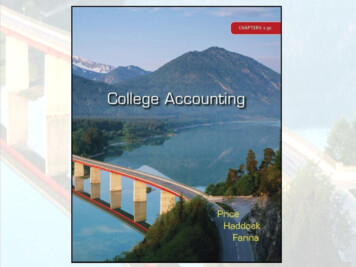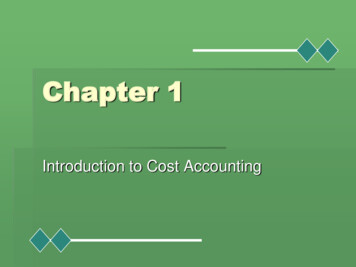
Transcription
Chapter 1Introduction to Cost Accounting
Learning ObjectivesLO1 Explain the uses of cost accountingdata.LO2 Describe the ethical responsibilitiesand certification requirements formanagement accountants.LO3 Describe the relationship of costaccounting to financial andmanagerial accounting.
Learning ObjectivesLO4 Identify the three basic elements ofmanufacturing costs.LO5 Illustrate basic cost accountingprocedures.LO6 Distinguish between the two basictypes of cost accounting systems.LO7 Illustrate a job order cost system.
The Need for CostAccounting Cost accounting provides the detailed costdata that management needs to control currentoperations and plan for the future. Companies must control costs in order to keepprices competitive. In today’s global environment, cost informationis more crucial than ever in remainingcompetitive.
Types of Businesses ThatUse Cost Accounting Manufacturers (Ford, General Motors)Merchandisers (WalMart, Kmart)Wholesalers (Beverage Distributors)For-profit Service Businesses (CPAs,Attorneys) Not-for-profit Service Agencies (UnitedWay, Red Cross)
The ManufacturingProcess This process involves the conversion ofdirect (raw) materials, direct labor, andfactory overhead into finished goods. Product quality is an important competitiveweapon in manufacturing. Many companies require their suppliers tobe ISO 9000 certified.
ISO 9000 Certification The International Organization forStandardization created a set of fiveinternational standards for qualitymanagement, ISO 9000-9004. These standards require thatmanufacturers have a well-defined qualitycontrol system and they consistentlymaintain a high level of quality.
Determining ProductCosts and Pricing Cost accounting is used to determineproducts costs and help with marketingdecisions.1. Determining the selling price of aproduct.2. Meeting competition.3. Bidding on contracts.4. Analyzing profitability.
Planning and Control Planning is the process of establishingobjectives or goals for the firm anddetermining the means by which the firm willattain them. Effective planning is facilitated bythe following:1. Clearly defined objectives of themanufacturing operation.2. A production plan that will assist and guidethe company in reaching its objectives.
Planning and Control(cont.) Control is the process of monitoring thecompany’s operations and determiningwhether the objectives identified in theplanning process are being accomplished.Effective control is achieved through thefollowing:1. Assigning responsibility.2. Periodically measuring and comparingresults.3. Taking necessary corrective action.
Responsibility Accounting Responsibility accounting is the assignmentof accountability for costs or production resultsto those individuals who have the mostauthority to influence them. A cost center is a unit of activity within thefactory to which costs may be practically andequitably assigned. The manager of a costcenter is responsible for those costs that themanager controls.
Reporting Cost and production reports for a costcenter reflect all cost and production dataidentified with that center. The performance report will include onlythose costs and production data that thecenter’s manager can control. A variance is the favorable or unfavorabledifference between actual costs andbudgeted costs.
Performance ReportExampleRenaldi’s RestaurantPerformance ReportSeptember 30, 2006BudgetedActualExpenseKitchen WagesFoodSuppliesUtilitiesTotalF FavorableU UnfavorableSeptember 5,50017,7003,3001,850 28,350Year-to-Date 47,000155,30027,90015,350 245,550September 5,20018,3003,7001,730 28,930Year-to-Date 46,100157,60029,10016,200 249,000VarianceSeptember 300 F600 U400 U120 F 580 UYear-to-Date 900 F2,300 U1,200 U850 U 3,450 U
Management Accounting The Institute of Management Accountants(IMA) is the largest organization ofaccountants in industry. The CertifiedManagement Accountant (CMA) iscomparable to the Certified PublicAccountant (CPA) for public accountants. For more information, please visit theIMA’s website at www.imanet.org
Cost Accounting vs.Financial and ManagerialAccountingCost Accounting SystemCharacteristicsFinancial AccountingManagerial AccountingUsers: External Parties ManagersManagersFocus:Entire businessSegments of the businessUses of Cost Information:Product costs forcalculating cost of goodssold and finished goods,work in process, and rawmaterials inventory usinghistorical costs and GAAP. Budgeting Special decisions such asmake or buy a component,keep or replace a facility,and sell a product at aspecial price. Nonfinancial informationsuch as defect rates, % ofreturned products, and ontime deliveries
Cost Accounting vs.Financial and ManagerialAccounting (cont.) Cost accountingincludes those partsof both financial andmanagementaccounting thatcollect and analyzecost information.
Cost of Goods SoldMerchandiserManufacturerBeginning merchandiseinventoryBeginning finished goodsinventoryPlus purchasesPlus cost of goodsmanufacturedMerchandise available for saleLess ending merchandiseinventoryCost of good soldFinished goods available forsaleLess ending finished goodsinventoryCost of good sold
Inventories Most manufacturers maintain a perpetualinventory system that uses FIFO, LIFO, ormoving average methods of costing. An inventory ledger is maintained to providesupport for the control accounts. Some manufacturers may use a factoryledger, which contain all of the accountsrelating to manufacturing.
InventoriesMerchandiserCurrent assets:CashAccounts receivableMerchandiseinventoryManufacturerCurrent assets:CashAccounts receivableInventories:Finished goodsWork in processMaterials
Elements ofManufacturing Costs Direct materials Materials that become part of the finished goodand can be readily identified. Direct labor Labor of employees who work directly on theproduct manufactured. Factory overhead Includes all costs related to production otherthan direct materials and direct labor.
Prime Cost andConversion CostDirect MaterialsElementsof CostDirect LaborFactory OverheadPrime CostConversionCost
Flow of ManufacturingCostsDirect MaterialsDirect LaborFactory OverheadWork in Process(Assets)Finished Goods(Assets)Cost of Goods Sold(Expenses)
Illustration of Accountingfor Manufacturing Costs Materials Accounts PayableWork in Process (Direct Materials)Factory Overhead (Indirect Materials) MaterialsPayroll Wages PayableWages Payable CashWork in Process (Direct Labor)Factory Overhead (Indirect Labor)Selling & Admin Exp (Salaries) PayrollFactory Overhead (Depr. Bldg)Selling & Admin Exp (Depr. Bldg) Accum. Depr. – BldgFactory Overhead (Depr. Mach & Eq) Accum. Depr. – Mach & Eqxxxxxxxx xx xxxxxxxxxxxxxx xxxxxx xx xxxxFactory Overhead (Utilities)Selling & Admin Exp (Utilities) Accounts PayableSelling & Admin Exp Accounts PayableWork in Process Factory OverheadxxFinished Goods Work in ProcessAccounts Payable CashAccounts Receivable SalesCost of Goods Sold Finished GoodsCash Accounts Receivablexxxxxxxxxxxxxxxxxxxxxxxxxxxxxxxx
Cost Accounting Systems Job Order Cost System Output consists of special or custommade products. Provides a separate record for the costof each quantity of these special orcustom-made products. Process Cost System Accumulates costs for each departmentor process in the factory.
Job Order Cost SystemDirect MaterialsDirect LaborFactory OverheadWork in ProcessAccountJob Cost SheetsFinished GoodsAccount
Process Cost SystemWork in ProcessDept. 1DirectMaterialsDirectLaborFactoryOverheadWork in ProcessDept. 2DirectMaterialsDirectLaborFactoryOverheadFinished Goods
Standard Cost System May be used with either a job order or aprocess cost system. Uses predetermined standard costs to furnish ameasurement that helps management makedecisions regarding the efficiency of operation. Standard costs are costs that would be incurredunder efficient operating conditions and areforecast before the manufacturing processbegins.
AppendixStandards of Ethical Conduct forManagement Accountants Members of the IMA have an obligation tothe public, their profession, theorganizations they serve, and themselvesto maintain the highest standards ofethical Credibility
Appendix (cont.) Resolution of Ethical Conflict When applying the standards of ethicalconduct, IMA members may encounterproblems in identifying unethical behavior orin resolving an ethical conflict.1. Discuss problems with the immediate superior exceptwhen it appear that the superior is involved.2. Clarify relevant ethical issues by confidential discussionwith an objective advisor.3. Consult your own attorney as to legal obligations andrights concerning the ethical conflict.
Cost accounting is used to determine products costs and help with marketing decisions. 1. Determining the selling price of a product. 2. Meeting competition. 3. Bidding on contracts. 4. Analyzing profitability.
